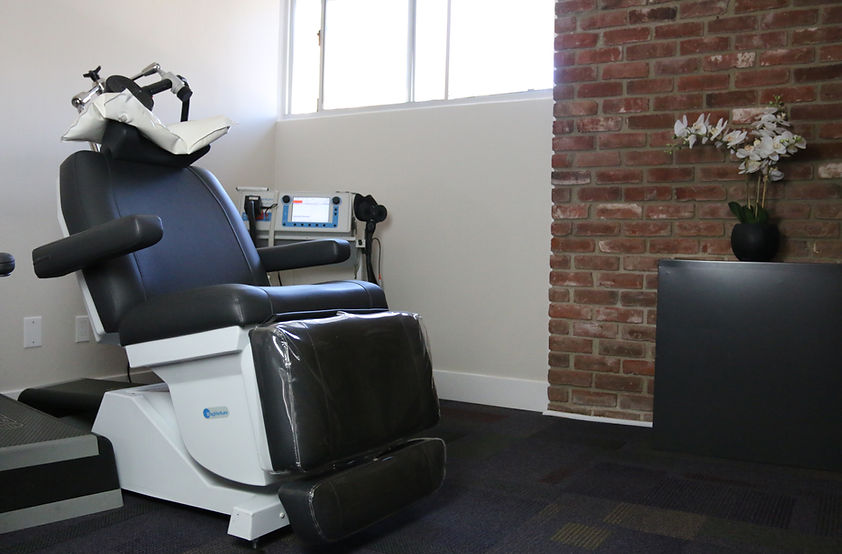


WE WILL FIGHT DEPRESSION TOGETHER
SILVERLINING℠ continues to be a cutting edge provider when it comes to the advancements in modern psychiatry.
According to several reputable clinical studies and our own experience, each failed antidepressant reduces the chance that the next one will work any better. After having tried and failed two to three antidepressants, the chances of treating depression with medication becomes progressively low. This form of depression has been called treatment resistant depression or TRD*. Both TMS and Spravato® are indicated for TRD. The focus of this page is on TMS.
Transcranial Magnetic Stimulation or TMS is designed and indicated by the FDA to treat resistant forms of depression. TMS uses a focused beam of the magnetic field that activates brain cells that otherwise would remain “sleepy” due to depression.
Not all TMS treatments are created equal. It is crucial that you receive treatment from a board certified psychiatrist trained on TMS. Wouldn’t you want to fight depression with the best experts in the field? This year we are celebrating 5 years and 10,000 hours of experience delivering TMS treatment.
We use state of the art European TMS equipment. Denmark based MagVenture® has been making TMS machines for several decades. What sets it apart is that it never overheats, as it is a liquid cooled machine. It is much quieter than its competitors and it is one of a few TMS systems that has the FDA designation for express (only three minutes long) TMS sessions. It is one of only two machines that are indicated for OCD. MagVenture® is the machine that Stanford uses for its break through research in TMS treatments.
Dr. Sivtsov was one of the first physicians to offer TMS in California. Most importantly, since he started his career in 1995, he has helped thousands of patients with depression. TMS has allowed Dr. Sivtsov to help those he could do little for before.
Learn more about TMS and if you qualify for this effective depression treatment option.
*Treatment Resistant Depression or TRD
Depression affects up to 25% of the American population during their lifetime and is the 3rd cause of morbidity and mortality in the US, after cancer and cardiovascular conditions. Of those afflicted by depression, approximately 30% develop TRD**. This term is used for Major Depressive Disorder that does not readily respond to antidepressants and/or talk therapy. There is no one consensus about it but generally speaking, if a person with depression tried and failed (that is did not feel better or could not take the medication secondary to the side-effects) two antidepressants from two different families of medications, their condition qualifies them for TMS treatment.
**J Clin Psychiatry 2021; 82(2):20m13699
Frequently Asked Questions About TMS
Why does TMS work?
TMS has been shown to produce changes in neuronal activity in regions of the brain implicated in mood regulation, such as the prefrontal cortex. As each magnetic pulse passes through the skull and into the brain, this induces brief activity of brain cells underlying the treatment coil.
The frequency of pulse delivery also influences whether brain activity is increased or decreased by a session of TMS. Recent studies also suggest that stimulation over the left and right sides of the brain can have opposite effects on mood regulation.
When is TMS used?
Antidepressant medications and psychotherapy are the first line treatments for major depression. These treatments, however, do not work for all patients. In these instances, rTMS might be used as an alternative treatment, or to augment antidepressant medications or psychotherapy. Patients who have failed to achieve an adequate response from antidepressants, or who are unable to tolerate medications, might consider TMS therapy.
What happens during an TMS procedure?
For each TMS session, the patient sits in a specially designed treatment chair, much like the kind used in a dentist’s office. Because TMS uses magnetic pulses, before beginning a treatment, patients are asked to remove any magnetic-sensitive objects (such as jewelry, credit cards). Patients are required to wear earplugs during treatment for their comfort and hearing protection, as TMS produces a loud clicking sound with each pulse, much like an MRI machine.
During the first TMS session, several measurements are made to ensure that the TMS coil will be properly positioned over the patient’s head. Once this is done, the TMS coil is suspended over the patient’s scalp. The TMS physician then measures the patient’s motor threshold, by administering several brief pulses. The motor threshold is the minimum amount of power necessary to make the patient’s thumb twitch, and varies from individual to individual. Measuring the motor threshold helps the physician personalize the treatment settings and determine the amount of energy required to stimulate brain cells.
Once the motor threshold is determined, the coil is then brought forward so that it rests above the front region of the patient’s brain. Treatment is then commenced. During the treatment, patients will hear a series of clicking sounds and will feel a tapping sensation under the treatment coil.
Succeeding treatment sessions do not require that the motor threshold be determined again, unless indicated otherwise, such as when changes in medications are made during the course of the treatment.
Who administers TMS?
TMS is always prescribed by a TMS physician. At SILVERLINING℠, all TMS physicians are specifically TMS credentialed. Motor threshold is determined by a TMS physician. The treatment itself is administered by an experienced TMS technician under the supervision of the TMS physician or by the TMS physician.
The TMS technician or physician will always be present to monitor the patient during the treatment. The patient can stop a treatment at any time by asking the staff member present.
How long is an TMS procedure?
TMS therapy involves a series of treatment sessions. Treatment sessions can last between 3 and 18 minutes each, depending on the protocol used and administered 5 days a week. A typical course of TMS is 6 weeks. However, this can vary depending on an individual’s response to treatment.
What are the side-effects of TMS?
TMS is well-tolerated and associated with few side-effects and only a small percentage of patients discontinue treatment because of these. The most common side-effect, which is reported in about half of patients treated with TMS, is headaches. These are mild and generally diminish over the course of the treatment. Over-the-counter pain medication can be used to treat these headaches.
About one third of patients may experience painful scalp sensations or facial twitching with TMS pulses. These too tend to diminish over the course of treatment although adjustments can be made immediately in coil positioning and stimulation settings to reduce discomfort.
Some TMS machines produces a relatively loud noise and because of this earplugs are given to the patient to use during the treatment. However, some patients may still complain of hearing problems immediately following treatment. No evidence suggests these effects are permanent if earplugs are worn during the treatment.
TMS has not been associated with many of the side-effects caused by antidepressant medications, such as gastrointestinal upset, dry mouth, sexual dysfunction, weight gain, or sedation.
The most potentially serious risk of TMS is seizures. However, the risk of a seizure is exceedingly low (<0.1%).
At SILVERLINING℠, we follow up-to-date safety guidelines that are designed to minimize the risk of seizures. While TMS is a safe procedure, it is important to point out that because it is a new treatment, there may be unforeseeable risks that are not currently recognized.

